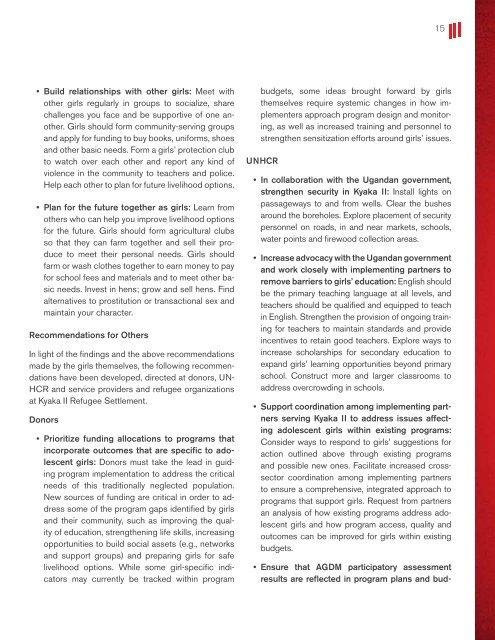Scattered Dreams, Broken Promises - Women's Refugee Commission
Scattered Dreams, Broken Promises - Women's Refugee Commission
Scattered Dreams, Broken Promises - Women's Refugee Commission
Create successful ePaper yourself
Turn your PDF publications into a flip-book with our unique Google optimized e-Paper software.
15<br />
• Build relationships with other girls: Meet with<br />
other girls regularly in groups to socialize, share<br />
challenges you face and be supportive of one another.<br />
Girls should form community-serving groups<br />
and apply for funding to buy books, uniforms, shoes<br />
and other basic needs. Form a girls’ protection club<br />
to watch over each other and report any kind of<br />
violence in the community to teachers and police.<br />
Help each other to plan for future livelihood options.<br />
• Plan for the future together as girls: Learn from<br />
others who can help you improve livelihood options<br />
for the future. Girls should form agricultural clubs<br />
so that they can farm together and sell their produce<br />
to meet their personal needs. Girls should<br />
farm or wash clothes together to earn money to pay<br />
for school fees and materials and to meet other basic<br />
needs. Invest in hens; grow and sell hens. Find<br />
alternatives to prostitution or transactional sex and<br />
maintain your character.<br />
Recommendations for Others<br />
In light of the findings and the above recommendations<br />
made by the girls themselves, the following recommendations<br />
have been developed, directed at donors, UN-<br />
HCR and service providers and refugee organizations<br />
at Kyaka II <strong>Refugee</strong> Settlement.<br />
Donors<br />
• Prioritize funding allocations to programs that<br />
incorporate outcomes that are specific to adolescent<br />
girls: Donors must take the lead in guiding<br />
program implementation to address the critical<br />
needs of this traditionally neglected population.<br />
New sources of funding are critical in order to address<br />
some of the program gaps identified by girls<br />
and their community, such as improving the quality<br />
of education, strengthening life skills, increasing<br />
opportunities to build social assets (e.g., networks<br />
and support groups) and preparing girls for safe<br />
livelihood options. While some girl-specific indicators<br />
may currently be tracked within program<br />
budgets, some ideas brought forward by girls<br />
themselves require systemic changes in how implementers<br />
approach program design and monitoring,<br />
as well as increased training and personnel to<br />
strengthen sensitization efforts around girls’ issues.<br />
UNHCR<br />
• In collaboration with the Ugandan government,<br />
strengthen security in Kyaka II: Install lights on<br />
passageways to and from wells. Clear the bushes<br />
around the boreholes. Explore placement of security<br />
personnel on roads, in and near markets, schools,<br />
water points and firewood collection areas.<br />
• Increase advocacy with the Ugandan government<br />
and work closely with implementing partners to<br />
remove barriers to girls’ education: English should<br />
be the primary teaching language at all levels, and<br />
teachers should be qualified and equipped to teach<br />
in English. Strengthen the provision of ongoing training<br />
for teachers to maintain standards and provide<br />
incentives to retain good teachers. Explore ways to<br />
increase scholarships for secondary education to<br />
expand girls’ learning opportunities beyond primary<br />
school. Construct more and larger classrooms to<br />
address overcrowding in schools.<br />
• Support coordination among implementing partners<br />
serving Kyaka II to address issues affecting<br />
adolescent girls within existing programs:<br />
Consider ways to respond to girls’ suggestions for<br />
action outlined above through existing programs<br />
and possible new ones. Facilitate increased crosssector<br />
coordination among implementing partners<br />
to ensure a comprehensive, integrated approach to<br />
programs that support girls. Request from partners<br />
an analysis of how existing programs address adolescent<br />
girls and how program access, quality and<br />
outcomes can be improved for girls within existing<br />
budgets.<br />
• Ensure that AGDM participatory assessment<br />
results are reflected in program plans and bud-






